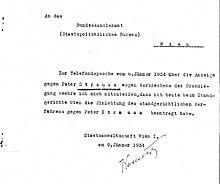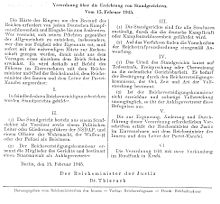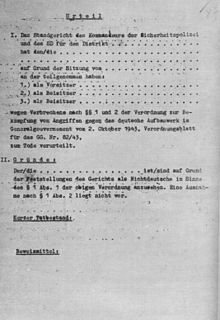Court martial
A court martial is an exceptional court for the suppression of uprisings and civil unrest.
The Supreme Commander in a place or camp can immediately confirm and execute the judgments. The martial law proclaimed is, the population and the soldiers declare that such special tribunals are used. The jurisdiction applies to everyone, that is, military and civilians. The legality of court court judgments that were made during the Nazi era in the final phase of World War II was in the criminal justice system in Germany until the first law to repeal unjust Nazi judgmentscontroversial from 1998. In Germany, exceptional courts - including standing courts - have been unconstitutional since 1949.
Germany
middle Ages
There are only a few records from Germany about the activity of court courts in the Middle Ages. One case dealt with a court martial of Duke Heinrich I of Braunschweig and Lüneburg in the Lüneburg Heath . He had succeeded his father as duke in 1388. In the course of a trip he took the halter from a horse's head and used it to hang the Vogt von Celle who was accompanying him on a tree because he had stolen a farmer's coat.
The German Imperium
According to the German Military Criminal Court Code of December 1, 1898, military tribunals were responsible for criminal matters of lower jurisdiction and were only allowed to recognize confiscation, imprisonment for up to six weeks and a fine of up to 150 marks. They consisted of a staff officer as chairman and a captain and a first lieutenant as assessors. Together with their deputies, they were appointed once and for all every year before the beginning of the judicial year and sworn in when the judge took office.
In wartime, field courts and on-board courts were set up on board naval vessels to investigate individual cases. In these cases the maximum sentences were imprisonment of up to three months and a fine of up to 300 marks. In addition, field and on-board courts could also recognize the transfer to the second class of the soldier's class .
time of the nationalsocialism
General war criminal proceedings
Within the Nazi military jurisdiction , the War Criminal Procedure Ordinance (KStVO) of August 17, 1938, which was not published in the Reichsgesetzblatt until 1939, provided for the “emergency jurisdiction” in Section 13. Thereafter, for "one of the military law subject person in the operating area" to "red-handed (z. B. with desertion the next available court Lord)" had been put in charge. In the combat area, the proceedings against accused suspected of espionage , rioting , a violation of a commander in the occupied foreign territory, the decomposition of military strength or the damage to military equipment could also be carried out by the nearest commander of a regiment.
On November 1, 1939, the War Criminal Procedure Code was supplemented by a section 13a, which uses the term "Standgerichte" in the heading:
- Section 13, Paragraph 1: “The nearest available commander of a regiment or a troop commander with the same disciplinary penalties can exercise the powers of the judge if
- 1. the sentencing cannot be postponed for compelling military reasons,
- 2. a judge cannot be reached on the spot and
- 3. the witnesses or other evidence are immediately available. "
Paragraph 2 of Section 13, however, restricted this provision. The court martial had no jurisdiction over criminal offenses, for which according to § 14 the Reich Court Martial should remain responsible. Among other things , this concerned treason , high treason , war treason , degradation of military strength and now also espionage .
When the German troops marched into Poland in 1939, trial courts were active that sentenced Polish civilians to death as suspected of rioting and had them shot .
Special court martial of the Wehrmacht
On June 21, 1943, Adolf Hitler signed an order at the Fuehrer's headquarters for the “formation of a central special court martial for the Wehrmacht .” It was supposed to judge political crimes in a fast-track process that “are directed against trust in the political and military leadership and when interpreting the a death sentence or imprisonment can be expected ”. This special court martial was responsible for all members of the Wehrmacht who were in the home war area. The judge was Hitler; The President of the Imperial Court Martial was to take care of the current business of the court lord.
The special court martial was affiliated to the Reich Court Martial as a special senate. An airplane was to be made available to the court on request.
This order was formally repealed and replaced by a "decree of the Führer on the prosecution of political crimes" of September 20, 1944. Until then, "political crimes" committed by military personnel were tried by the Reich Court Martial or the special court martial formed there; now the competence was withdrawn from them. For all members of the Wehrmacht, Waffen-SS and police - as with civilians - the People's Court and special courts were responsible for the judgment of political crimes.
Extension to civilians
On February 15, 1945, an "Ordinance on the Establishment of Stand-up Courts" signed by the Reich Minister of Justice Otto Thierack was issued. In all "enemy-threatened Reich defense districts" stand courts should be created. The tribunals were responsible for all crimes "by which the German fighting strength and determination to fight" was endangered. This meant that not only military personnel but also all civilians were subject to the judgment of the court martial.
The locally responsible Reich Defense Commissioner appointed the three members of the court and the responsible public prosecutor; A criminal judge had to be appointed as chairman, the other two members of the court were each a political leader or branch leader of the NSDAP and an officer of the Wehrmacht , the Waffen-SS or the police. The ordinary procedural rules were only applied "analogously" to the procedure. The only possible judgments were the death penalty, acquittal or referral to an ordinary criminal court. The verdict required the confirmation of the competent Reich Defense Commissioner, who also determined the enforcement, in his place of the prosecutor at the court.
The regulation came into force when it was promulgated by the radio. Essential provisions contradict the rule of law: For example, the order of jurisdiction and applicable penal norms are so imprecisely described that they could give room to any arbitrariness. Only one lawyer served as judge alongside a political and a military or police functionary. A judicial assessment of the sentence could hardly be carried out, since only the death penalty and acquittal were allowed as extreme opposites; referral to a proper criminal court, which could also pronounce penalties between these two extremes, was only an insufficient compensation for this deficiency.
Flying stand court
The term "flying court martial" was presumably in use from the spring of 1944, when special police units with the designation OKW-Feldjäger were set up, which were authorized on the spot by means of specially added mobile units according to the directive of the top military leadership apart from military hierarchies and competencies of the field gendarmerie To make court judgments and to have them enforced immediately.
On March 9, 1945 the order was given by the “Führer Decree” to set up a “flying stand trial” immediately. The court was directly subordinate to Adolf Hitler and received orders from him alone.
The “flying stand trial” was “responsible for criminal acts by members of all parts of the armed forces and the Waffen-SS regardless of rank” and could also attract pending proceedings. The longest-serving officer led the investigation as the judge, chaired the main hearing and made the enforcement decision. The right of grace no longer applies.
The term “flying stand trial” - partly restricted as “so-called flying stand trial” - also appears incidentally in the literature, but is not supported by a reference to a further formal enactment with legal force.
Dealing with judgments after the end of the war
Numerous people fell victim to the verdicts of the court courts, which were formed from February 1945 onwards: estimates are based on several thousand civilians. After the end of the war, the Allied military courts primarily tried Nazi crimes that had been committed against their own nationals or against those of their allies. Only later did the Allies authorize German courts to take action against German Nazi perpetrators in accordance with Control Council Act No. 10 . German courts found it difficult to judge on this basis and increasingly resorted to German criminal law. The far-reaching interpretation of the so-called judge's privilege meant that those involved in extreme court martial judgments were only convicted in a legally binding manner in rare cases.
When Nazi injustice judgments were legally overturned , the victims of the court martial and the victims of the Nazi military justice were excluded for a long time. It was not until 1998 that the law for the repeal of National Socialist judgments in criminal justice also repealed the judgments of the court courts. The draft law also intended to overturn the judgments of the Nazi military justice system that had been pronounced against deserters . This did not find a majority in the Bundestag in 1998 and was only passed in 2002.
Germany from 1949
“Stand courts” in the sense of an exceptional court are prohibited in the Federal Republic of Germany according to Art. 101 Para. 1 Clause 1 of the Basic Law . In the GDR they were "inadmissible" from 1949 under Article 134 sentence 2 and later under Article 101, Paragraph 2. Criminal offenses are to be brought before the ordinary courts . In disciplinary matters involving soldiers, on the other hand, the troop service courts, which are under the hierarchy of administrative jurisdiction, are responsible.
Austria
1933 to 1938
During Austria's authoritarian form of government between 1933 and 1938 (“ Ständestaat ” or “ Time of Austrofascism ”, official name: Federal State of Austria ), Chancellor Engelbert Dollfuss decided to impose martial law at the meeting of the Council of Ministers on November 10, 1933; it came into effect the next day. It applied to the crimes of murder, arson and the crime of public violence and was directed against people who were caught in the act or whose guilt could be established without delay.

The procedural proceedings were conducted by a “flying senate” consisting of four judges and a public prosecutor, who had its seat at the Higher Regional Court of Vienna and, if necessary, traveled to the responsible regional court, and lasted a maximum of three days. With unanimous affirmation of the question of guilt, it ended with a death sentence, which had to be carried out after a maximum of three hours at the choke bar . For this reason, the "flying senate" often traveled to the place of negotiation together with the executioner .
No legal remedy was permitted against the judgment of the stand judge, only a pardon by the Federal President to life imprisonment was possible. With the imposition of martial law, the death penalty was reintroduced in Austria, which had already been abolished in the ordinary process in 1920.
The first stand trial took place in Wels on December 14, 1933, but the Federal President converted the death sentence into a prison sentence. At the second stand trial in Graz on January 10, 1934, the petition for clemency was not submitted to the Federal President and the day laborer Peter Strauss was executed for arson.
By emergency ordinance from February 12 to 21, 1934, the crime of "riot" according to §§ 73, 74 StG 1852 was also made subject to court jurisdiction. In June 1934, a change in the law reintroduced the death penalty for due process. On July 12, 1934, the court courts were also given jurisdiction over offenses related to bomb attacks and the illegal possession of explosives.
If the civil court martial came mainly after the February fighting in 1934, a military court martial was created in accordance with the law on the introduction of a military tribunal that came into force on July 26, 1934. This was primarily intended for those involved in the July coup , many of whom had come from the ranks of the executive and the armed forces. The military tribunal established in this way was similar in composition, conduct of proceedings and competencies to civil martial arts, except that four officers acted as judges at the military tribunal. The people arrested after the July coup were divorced by the public prosecutor's office into “serious” and “minor” parties. Those seriously involved (leaders, militants, couriers, etc.) were transferred to the military tribunal to try their coup-related offenses even if proceedings were pending before an ordinary court or a civil court martial. The urgent trials ended with numerous death sentences, 13 of which were carried out, including Otto Planetta .
Over 40 people were executed in Austria between 1933 and 1938 .
literature
- Peter Kalmbach: Stand courts in Northern Germany. In: Heimat-Rundblick . History, culture, nature. No. 104, 1/2013 ( spring 2013 ). Druckerpresse-Verlag, ISSN 2191-4257 , p. 30.
- Peter Kalmbach: Wehrmacht Justice. Metropol Verlag, Berlin 2012, ISBN 978-3-86331-053-0 .
- Jörg Friedrich : acquittal for the Nazi judiciary. The judgments against Nazi judges since 1948. Documentation. Revised and supplemented edition. Ullstein, Berlin 1998, ISBN 3-548-26532-4 , pp. 73-138 (= case presentation and criminal investigation).
- Martin Moll (Ed.): "Führer-Erasse" 1939–1945. Edition of all surviving directives in the fields of state, party, economy, occupation policy and military administration issued by Hitler in writing during the Second World War, not printed in the Reichsgesetzblatt. Franz Steiner Verlag, Stuttgart 1997, ISBN 3-515-06873-2 .
- Reichsgesetzblatt , 1939 and 1945.
- Court martial . In: Heinrich August Pierer , Julius Löbe (Hrsg.): Universal Lexicon of the Present and the Past . 4th edition. tape 16 . Altenburg 1863, p. 682 ( zeno.org ).
Web links
Individual evidence
- ↑ Matthias Blazek: Duke Heinrich's court martial in the Heide - a Lüneburg incident from the life of Duke Heinrich von der Haide . In: Braunschweiger Kalender 2010 . Joh. Heinr. Meyer Verlag, Braunschweig 2010, p. 99 ff.
- ↑ Ordinance on military criminal proceedings in war and in the event of special use (War Criminal Procedure Ordinance KStVO) of August 17, 1938, RGBl. 1939 Part I, p. 1457 ff.
- ↑ Fourth ordinance for the implementation and amendment of the ordinance on military criminal proceedings in war and with special use of November 1, 1939, RGBl. 1939 Part I, p. 2132 f.
- ^ Jochen Böhler: Prelude to the War of Extermination, Frankfurt / M. 2006, ISBN 3-596-16307-2 , p. 117.
- ↑ Doc. 255 in: Martin Moll (Ed.): “Führer-Erasse” 1939–1945. Stuttgart 1997, ISBN 3-515-06873-2 , p. 342 f.
- ↑ Doc. 364 in: Martin Moll (Ed.): "Führer-Erasse" 1939–1945. Stuttgart 1997, ISBN 3-515-06873-2 , p. 458.
- ^ Reichsgesetzblatt , 1945, Part I, p. 30
- ↑ Peter Lutz Kalmbach: Feldjäger, Security Service, Special Commands. Police organs and court jurisdiction in the final phase of the Second World War . In: Kriminalistik , 2014, pp. 454–458, 454 f.
- ↑ by Martin Moll: "Führer-Erasse" 1939–1945: Edition of all handed down directives from the areas of state, party, economy, occupation policy and military administration issued by Hitler during the Second World War, not printed in the Reichsgesetzblatt . Steiner, Stuttgart 1997, ISBN 3-515-06873-2 (accessed December 22, 2014).
- ^ Jörg Friedrich : acquittal for the Nazi judiciary . revised and additional edition. Berlin 1998, ISBN 3-548-26532-4 , p. 439.
- ↑ The flying stand trial of the commander in military district III, which must not be confused with the “flying stand trial of the Führer”, was set up on February 13, 1945 by order of the commander in military district III. Expert opinion by Norbert Haase: Wehrmacht shooting site in Ruhleben ("Murellenschlucht"). 1995
- ↑ Wolfgang Benz u. a. (Ed.): Encyclopedia of National Socialism. Munich 1997, p. 747.
- ^ Jörg Friedrich : acquittal for the Nazi judiciary . revised and additional edition. Berlin 1998, ISBN 3-548-26532-4 , pp. 73-138.
- ↑ bundestag.de (PDF; 126 kB)
- ^ The Constitution of the German Democratic Republic (October 7, 1949) . documentarchiv.de; Retrieved August 14, 2011
- ^ Constitution of the German Democratic Republic of April 6, 1968 . documentarchiv.de; Retrieved August 14, 2011
- ↑ The then 26-year-old farmer's son Johann Breitwieser injured the 19-year-old maid Hilde Strasser, who was impregnated by him, so badly with knife stabs on his parents' farm in Mitterfils, Pennewang municipality that she died of it shortly after fleeing to a neighbor. The death sentence against Breitwieser for murder was made the day after the trial began, what justice minister Kurt Schuschnigg said at that time in Mallnitz , who remained President submitted a pardon and the death penalty five minutes before the scheduled execution Breitwieser by the executioner Johann Lang in a life sentence was converted. At the time, the stand trial was reported in detail in all of the major Austrian newspapers - see ANNO - AustriaN Newspapers Online for 1933.
- ^ Austrofascism and memory: Josef Ahrer , accessed on August 21, 2018
- ↑ Federal Law Gazette No. 77/1934

